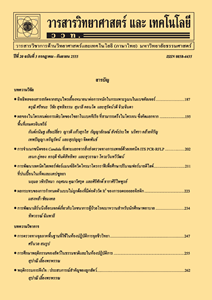การประเมินประสิทธิภาพของสโมสรฟุตบอลในไทยพรีเมียร์ลีกโดยใช้วิธีการโอบล้อมข้อมูลแบบจัดเรียงประสิทธิภาพ
Main Article Content
Abstract
Abstract
Football is the popular sports in Thailand and has high influence on the nation economy. Thai Premier League is football competition at the top of Thai football league system. The objective of the paper is to evaluate both sportive and financial efficiency of football clubs in Thai Premier League during 2014-2015 football seasons by using Data Envelopment Analysis (DEA) models: Cross efficiency DEA and Super efficiency DEA. We consider two input factors as follows: the stadium capacity and the administrative expenses. The output variables investigated on the efficiency of football clubs are the number of supportive attendances, the total score in 2016, the total revenues, net assets, the number of trophies, the qualification for AFC for the last and the next season, the qualification for Thai Premier League for the last and the next season. The results show that two football clubs are not efficient. Later, it is found that both football clubs mentioned are relegated to lower league in the next competition 2016/2017. Buriram, SCG Muangthong United, and Chonburi Football Club are in the top rank with the high cross efficiency score. This evidence illustrates that both models can be successively to measure the efficiency and rank the football clubs in Thai Premier League.
Keywords: data envelopment analysis; football club; cross efficiency DEA; super efficiency DEA
Article Details
References
[2] Toyota Thai League, แฟนตาซี ไทยลีก, Available Source: http://www.thaileague.co.th/official, August, 2017.
[3] Haas, D.J., 2003, Productive efficiency of English football teams: A data envelopment analysis approach, Manag. Decis. Econ. 24: 1099-1468.
[4] Kulikova, L. and Goshunova, A., 2014, Efficiency measurement of professional football clubs: A non-parametric approach, Life Sci. J. 11: 117-122.
[5] Pyatunin, A.V., Vishnyakova, A.B., Sherstneva, N.L., Mironova, S.P., Dneprov, S.A. and Grabozdin, Y.P., 2016, The economic efficiency of European football clubs: Data envelopment analysis (DEA) approach, Int. J. Environ. Sci. Educ. 11: 7515-7534.
[6] Namkunee, T., 2015, Factors Relating to Sport Performance and Financial Performance of Football Clubs in Thailand, M.S. thesis, Suranaree University of Technology, Nakhon Ratchasima.
[7] Farrell, M.J., 1957, The measurement of productive efficiency, J. Royal Stat. Soc. 120: 253-290.
[8] Charnes, A.W., Cooper, W. and Rhodes, E., 1978, Measuring the efficiency of DMUs, Eur. J. Oper. Res. 2: 429-444.
[9] Coelli, T., Prasada Rao, D.S and Battese, G.E., 1998, An Introduction to Efficiency and Productivity Analysis, Kluwer, Boston.
[10] Sexton, T.R., Silkman, R.H. and Hogan, A.J., 1986, Data envelopment analysis: Critique and extensions, New Direct. Progr. Eval. 32: 73-105.
[11] Andersen, P. and Petersen, N.C., 1993, A procedure for ranking efficient units in data envelopment analysis, Manag. Sci. 39: 1261-1265.
[12] Spearman, C., 1904, The proof and measurement of association between two things, Amer. J. Psychol. 15: 72-101.


